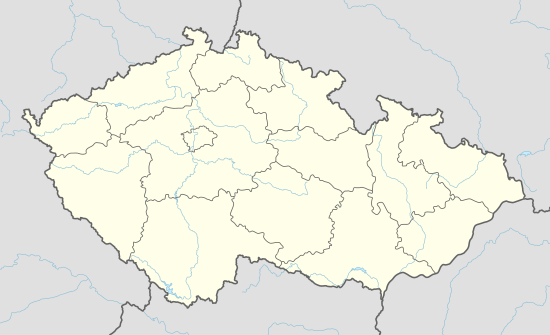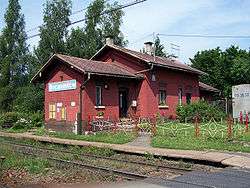Bocanovice
| Bocanovice Boconowice | |||
|---|---|---|---|
| Village | |||
|
Railway station in the village | |||
| |||
 Location in the Czech Republic | |||
| Coordinates: 49°33′52″N 18°43′40″E / 49.56444°N 18.72778°ECoordinates: 49°33′52″N 18°43′40″E / 49.56444°N 18.72778°E | |||
| Country | Czech Republic | ||
| Region | Moravian-Silesian | ||
| District | Frýdek-Místek | ||
| First mentioned | 1621 | ||
| Government | |||
| • Mayor | Ing. Martin Paduch | ||
| Area | |||
| • Total | 3.77 km2 (1.46 sq mi) | ||
| Population (2010) | |||
| • Total | 445 | ||
| • Density | 120/km2 (310/sq mi) | ||
| Postal code | 739 91 | ||
| Website |
www | ||
![]() Bocanovice (Polish: Boconowice ) is a village in the Moravian-Silesian Region of the Czech Republic. It has 428 inhabitants (2001 census), 30.9% of the population are ethnic Poles and 80.8% are Roman Catholics.[1]
Bocanovice (Polish: Boconowice ) is a village in the Moravian-Silesian Region of the Czech Republic. It has 428 inhabitants (2001 census), 30.9% of the population are ethnic Poles and 80.8% are Roman Catholics.[1]
It is situated on the foothills of the Moravian-Silesian Beskids mountain range, in the historical region of Cieszyn Silesia. Lomná River flows through the village.
The name is patronymic in origin derived from personal name (or nickname) Bocon (similar to the word bocian meaning stork in Polish).[2]
History
The village was first mentioned in 1621 as Boczanowicze.[2][3] It belonged then to the Duchy of Teschen, a fee of the Kingdom of Bohemia and a part of the Habsburg Monarchy.
After Revolutions of 1848 in the Austrian Empire a modern municipal division was introduced in the re-established Austrian Silesia. The village as a municipality was subscribed to the political district of Cieszyn and the legal district of Jablunkov. According to the censuses conducted in 1880, 1890, 1900 and 1910 the population of the municipality grew from 282 in 1880 to 330 in 1910 with the majority being native Polish-speakers (between 96.6% and 99.1%) accompanied by few German-speaking (at most 9 or 3.1% in 1890) and Czech-speaking people (at most 2 or 0.6% in 1900). In terms of religion in 1910 the majority were Roman Catholics (80.3%), followed by Protestants (19.7%).[4] The village was also traditionally inhabited by Cieszyn Vlachs, speaking Cieszyn Silesian dialect.
After World War I, fall of Austria-Hungary, Polish–Czechoslovak War and the division of Cieszyn Silesia in 1920, it became a part of Czechoslovakia. Following the Munich Agreement, in October 1938 together with the Zaolzie region it was annexed by Poland, administratively adjoined to Cieszyn County of Silesian Voivodeship.[5] It was then annexed by Nazi Germany at the beginning of World War II. After the war it was restored to Czechoslovakia.
From 1975 to 1990 the village was administratively a part of Jablunkov.
Footnotes
- ↑ "2001 census data". Czech Statistical Office.
- 1 2 Mrózek, Robert (1984). Nazwy miejscowe dawnego Śląska Cieszyńskiego [Local names of former Cieszyn Silesia] (in Polish). Katowice: Uniwersytet Śląski w Katowicach. pp. 42–43. ISSN 0208-6336.
- ↑ Panic, Idzi (2011). Śląsk Cieszyński w początkach czasów nowożytnych (1528-1653) [Cieszyn Silesia in the beginnings of Modern Era (1528-1653)] (in Polish). Cieszyn: Starostwo Powiatowe w Cieszynie. p. 171. ISBN 978-83-926929-5-9.
- ↑ Piątkowski, Kazimierz (1918). Stosunki narodowościowe w Księstwie Cieszyńskiem (in Polish). Cieszyn: Macierz Szkolna Księstwa Cieszyńskiego. pp. 266, 284.
- ↑ "Ustawa z dnia 27 października 1938 r. o podziale administracyjnym i tymczasowej organizacji administracji na obszarze Ziem Odzyskanych Śląska Cieszyńskiego". Dziennik Ustaw Śląskich (in Polish). Katowice. nr 18/1938, poz. 35. 31 October 1938. Retrieved 1 July 2014.
References
- Sikora, Jacek (2007-09-29). "Po europejsku". Głos Ludu. p. 1.
External links
| Wikimedia Commons has media related to Bocanovice. |
- (Czech) Official website




